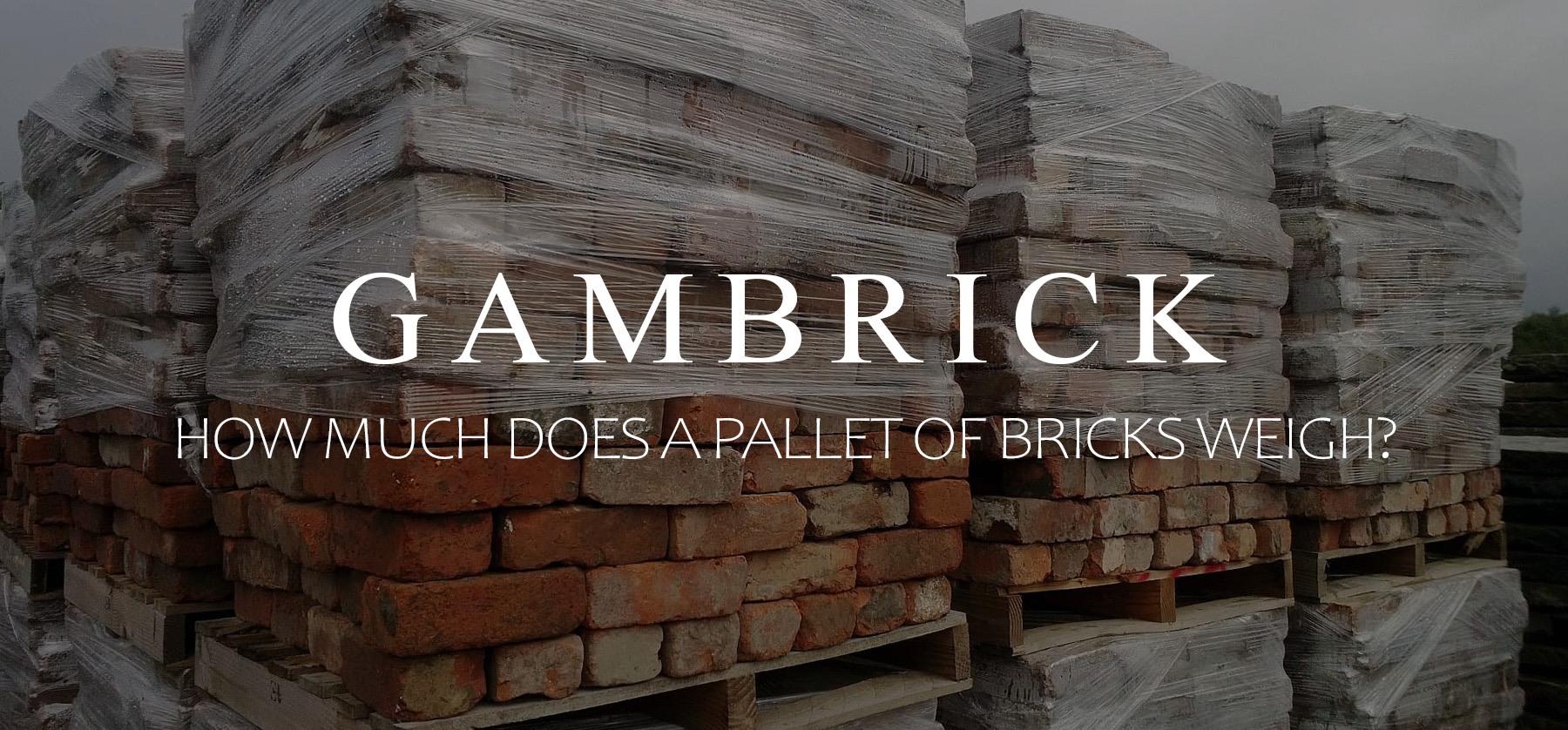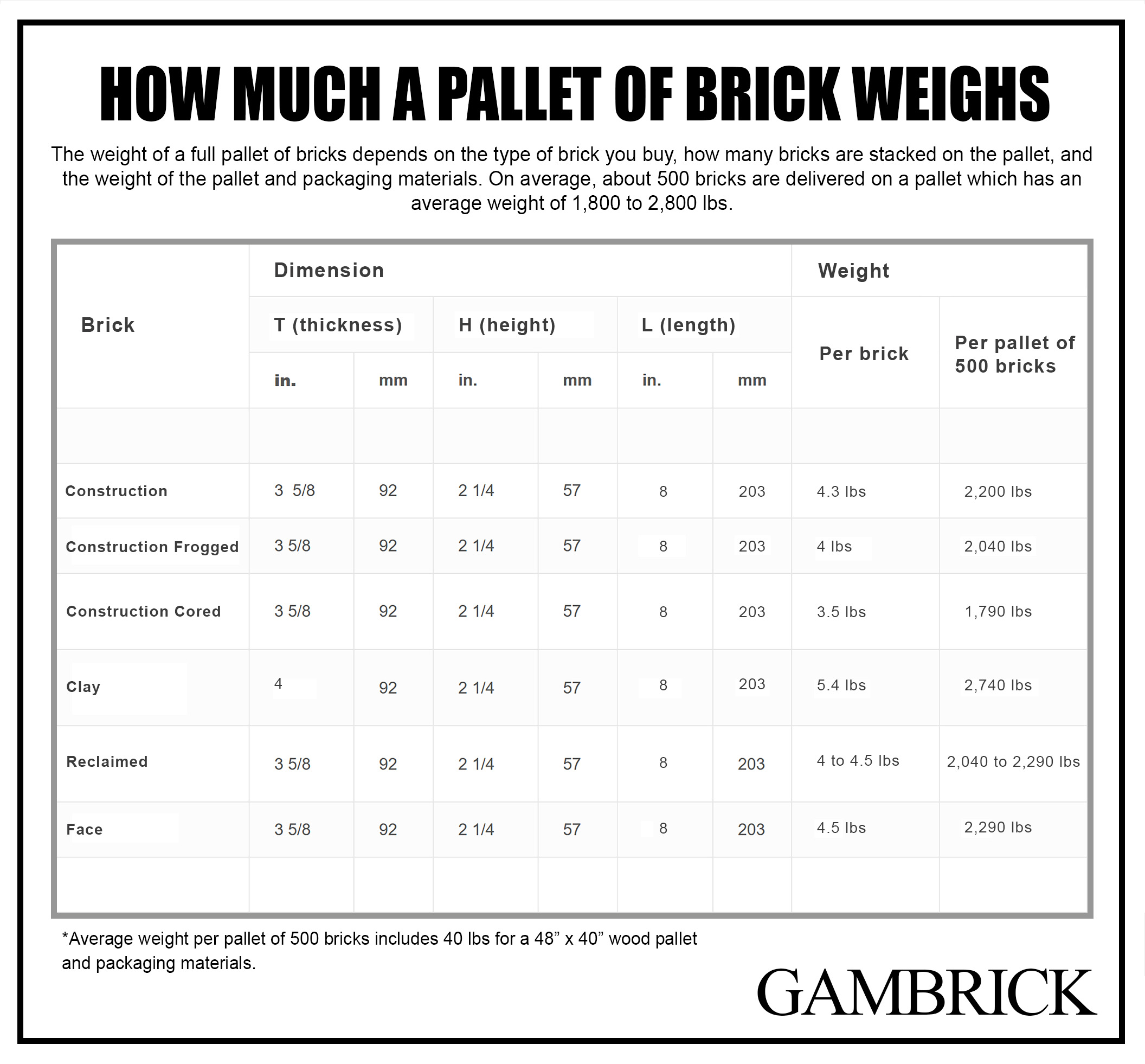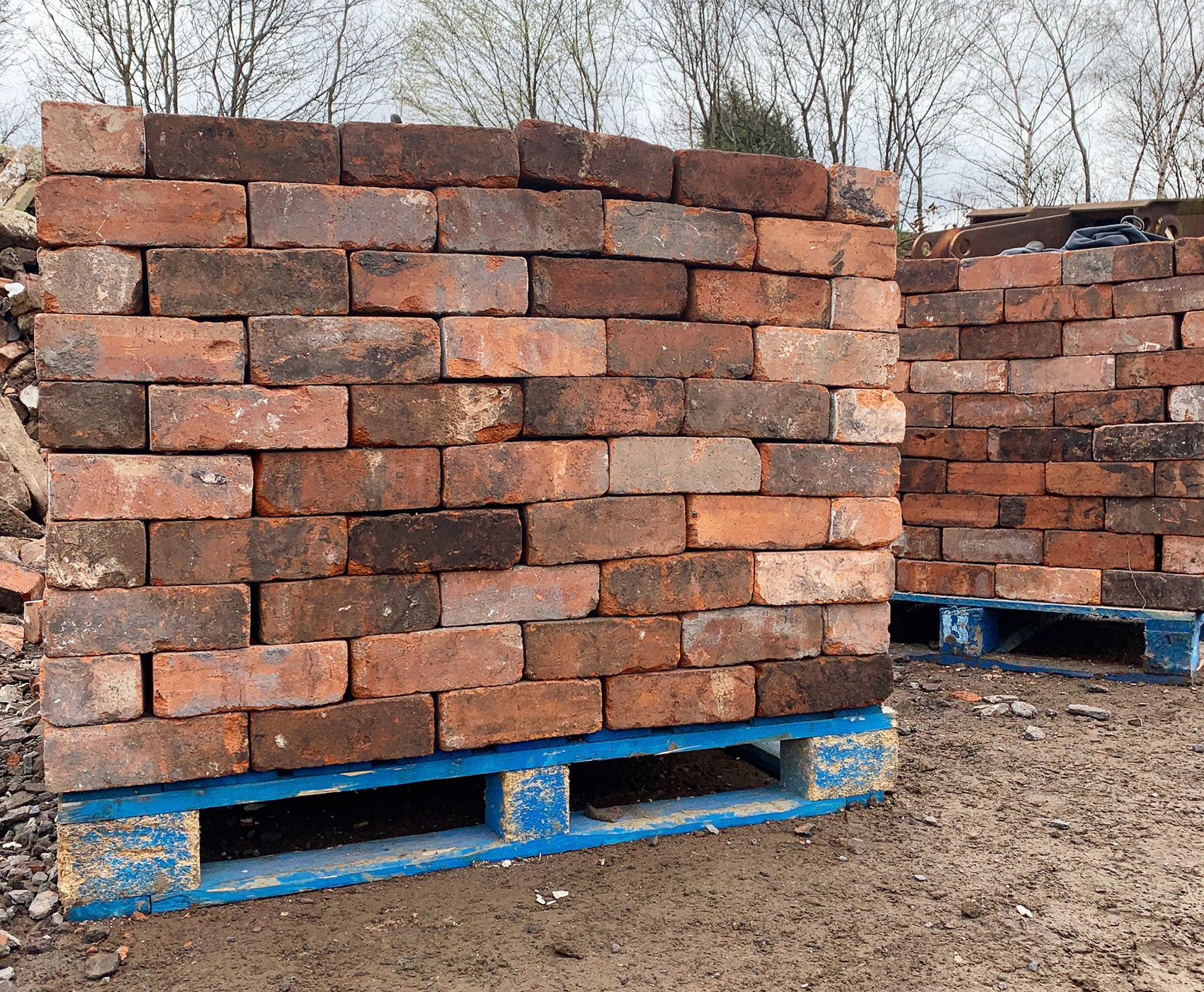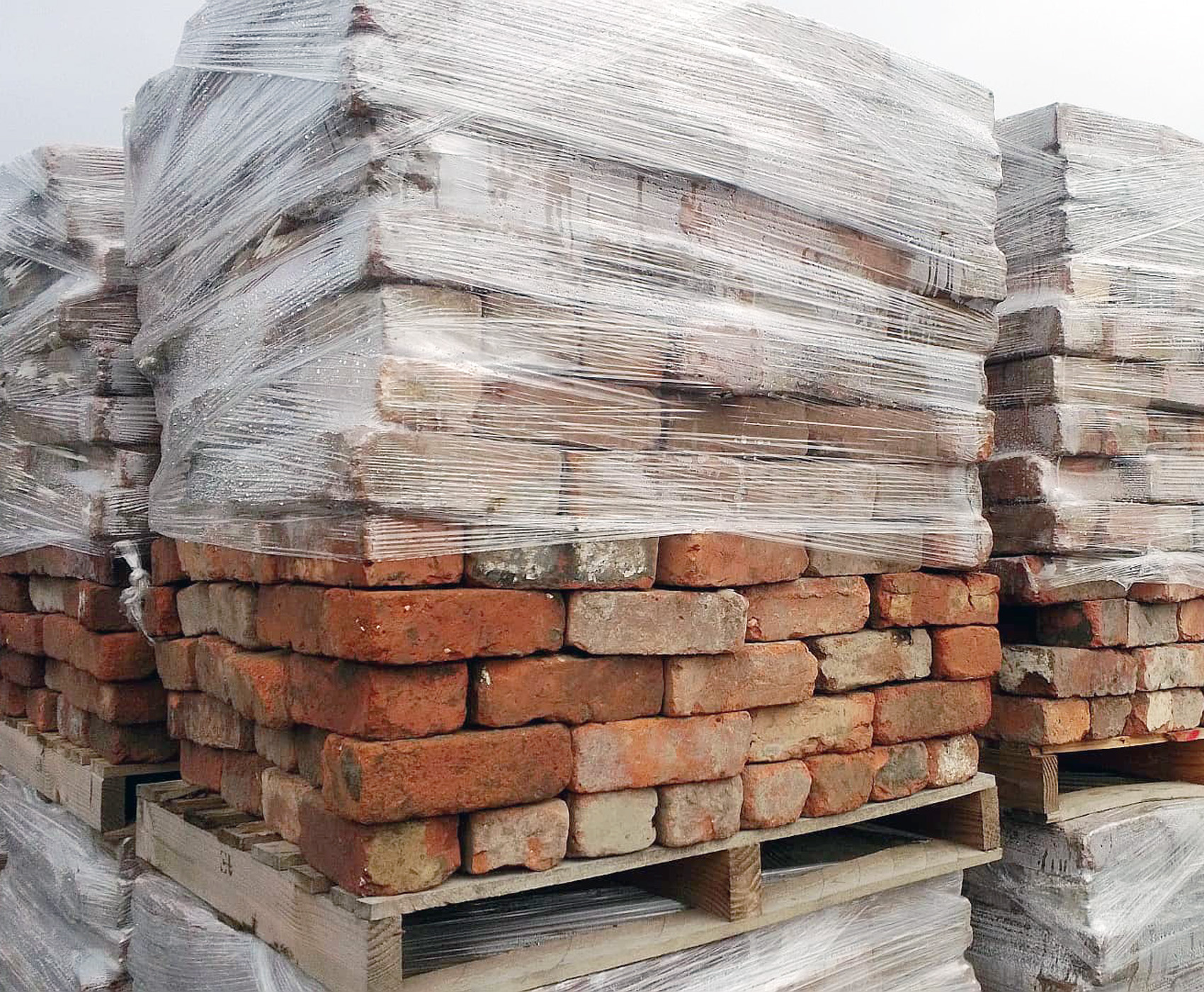How Much Does A Pallet Of Bricks Weigh?
How much a pallet of bricks weighs depends on several factors which includes the type and size brick, the size of the pallet and how high the bricks are stacked.
The standard size brick pallet is 48″ x 40″. A typical construction brick is 8 inches long x 3 5/8 inches wide x 2 1/4 inches tall and weighs 4.3 pounds. When bricks are laid face down on a pallet, there are typically about 50 per row. If the pallet is stacked 2 feet high, it can hold about 10 rows of bricks. 10 rows x 50 bricks equals 500 bricks per pallet. Multiply 500 x 4.3 lbs per brick and you get 2,150 lbs of bricks per pallet. Then you have to add packaging materials and the weight of the pallet which is around 40 lbs. In total, a pallet holding 500 construction bricks weighs about 2,200 lbs which is just over a ton.
A pallet of red clay paver bricks from Home Depot comes with 240 bricks. Each brick is 8 inches long x 4 inches wide x 2 1/4 inches tall and weighs 5.4 lbs. Home Depot uses a standard 48 inch x 40 inch pallet but only stacks 240 bricks per pallet. 240 x 5.4 = 1,296 lbs worth of bricks + 40 lbs for the pallet and packing materials. In total, a pallet of red clay paver bricks from Home Depot weighs about 1,340 lbs.
As you can see from these real world examples, how much a pallet of bricks weighs depends largely on the type of brick you buy and how many are stacked on the pallet.
In this article, we’ll discuss the most common types of bricks, their dimensions, weight, how many come on a pallet and how much the pallet weighs.
Factors That Affect The Weight Of A Brick Pallet
There are several factors that can affect the weight of a pallet of brick. These include the type of brick, the size and weight of the brick, the number of bricks on the pallet, the packaging materials used and the weight of the pallet. The standard size pallet that’s used to deliver bricks is 48 inch x 40 inch and weighs about 40 lbs.
A 48 inch x 40 inch pallet is the most common size because it’s designed to fit with a standard size fork lift. Unless you order an extremely large amount of bricks for a commercial or industrial project, this is the pallet your bricks will be delivered on.
In terms of packaging materials, bricks are typically wrapped in plastic or metal bands. At most, the packaging adds a few pounds to the total.
Whenever I order bricks and need to figure out the weight of the pallet, I generally multiply the number of bricks I’m ordering x the weight per individual brick and add 45 lbs for the pallet and packaging materials.
Type Of Brick
The type of brick being used is one of the biggest factors that determines how much a pallet of bricks weighs. Different types of bricks have varying densities and composition which will impact their overall weight. For example, red construction bricks are generally about a pound lighter than clay bricks.
Some bricks have holes in them to make them lighter and hold mortar. These are called cored bricks. Because they have holes, cored bricks use less material which makes them cheaper to produce and lighter. However they’re still very strong and durable.
Size Of The Brick
The size of the brick is another important factor that can affect how much a pallet of brick weighs. Larger bricks will naturally weigh more than smaller bricks if they’re made of the same material. However, a larger bricks isn’t always heavier.
Just because a brick is larger doesn’t mean it’s necessarily heavier. For example, clay bricks are heavier than construction bricks per square inch because clay is a dense material. So a smaller clay brick will actually be the same weight or even heavier than a larger construction brick. This is especially true if the construction brick is cored.
When buying bricks and figuring out how much a pallet weighs, consider both the size of the brick and the material its made out of.
Number Of Bricks On The Pallet
The number of bricks on a pallet is one of the biggest factor that effects how much the pallet weighs. Pallets with more bricks will generally weigh more than pallets with fewer bricks, it’s that simple. However, this is only true if you’re comparing pallets carrying the same brick.
Just because pallet (A) has more bricks on it than pallet (B), doesn’t mean it weighs more. For example, a construction brick weighs about 4.3 lbs while a red clay brick weighs about 5.4 lbs. If pallet (A) has more construction bricks than pallet (B) which holds clay bricks, pallet (A) can actually be lighter. This is especially true if the construction bricks are cored to reduce weight.
This is an important consideration for shipping and transportation purposes as heavier pallets may require special handling equipment.
When determining how much a pallet of bricks weighs, consider the type of brick, its size and the number of bricks on the pallet. Never assume that your truck can carry the safely pallet without knowing how much it weighs.
Weight Of Different Types Of Brick Pallets
How much a pallet of bricks will weigh depends greatly on the type of brick being used. Bricks are sold in a variety of sizes and made out of different materials. For example, the average red construction bricks is 8 inches long x 3 5/8 inches wide x 2 1/4 inches tall and weighs 4.3 pounds. But the average clay brick is 8 inches long x 4 inches wide x 2 1/4 inches tall and weighs 5.4 lbs. Which brick you’re using will effect how much a full pallet weighs.
The brick design play a role in how much a pallet weighs too. There are 3 basic types of bricks which all have different weights:
- Solid: Solid bricks weigh the most because they’re completely solid, square and flat on all side.
- Frog: Bricks that are frogged have an indentation on both faces which decreases their weight.
- Core: Bricks with holes are called cored bricks. Because the center of the brick is hollow, they’re the lightest type of brick design you can use.
In this section, we will explore the approximate weight of different types of brick pallets commonly used in construction.
Clay Bricks
Clay bricks are a popular choice for construction projects, thanks to their durability and aesthetic appeal. The weight of a pallet of clay bricks can vary depending on the size and thickness of the brick. Clay is a dense and heavy material which is why clay bricks weigh more than standard red construction bricks.
A pallet of red clay paver bricks from Home Depot comes with 240 bricks. Each brick is 8 inches long x 4 inches wide x 2 1/4 inches tall and weighs 5.4 lbs.
Home Depot uses a standard 48 inch x 40 inch pallet but only stacks 240 bricks per pallet. 240 x 5.4 = 1,296 lbs worth of bricks + 40 lbs for the pallet and packing materials. In total, a pallet of red clay paver bricks from Home Depot weighs about 1,340 lbs.
If you buy red clay paver bricks from other suppliers they usually ship 500 bricks per pallet. In this case, the pallet would weigh about 2,740 lbs.
Red Construction Bricks
Red construction bricks are the standard brick used in most construction projects. They’re 8 inches long x 3 5/8 inches wide x 2 1/4 inches tall and weigh 4.3 pounds. Red bricks come cored, frogged or solid.
A typical pallet of solid red bricks contains 50 bricks per row and holds 10 rows of bricks. 10 rows x 50 bricks equals 500 bricks per pallet. Multiply 500 x 4.3 lbs per brick and you get 2,150 lbs of bricks per pallet. Then you have to add packaging materials and the weight of the pallet which is around 40 lbs. In total, a pallet holding 500 construction bricks weighs about 2,200 lbs which is just over a ton.
Reclaimed Bricks
Reclaimed bricks have become increasingly popular due to their unique character and history. The weight of a pallet of reclaimed bricks can vary depending on the size, thickness, and age of the bricks. Because reclaimed bricks are older, they’re size, condition and weight varies more than new bricks.
The average reclaimed red brick is about 8 inches long x 3 5/8 inches wide x 2 1/4 inches tall and weighs between 4 and 4.5 pounds.
A typical pallet of solid reclaimed red bricks typically contains 50 bricks per row and holds 10 rows of bricks. 10 rows x 50 bricks equals 500 bricks per pallet. Multiply 500 x 4 to 4.5 lbs per brick and you get 2,000 and 2,250 lbs of bricks per pallet. Then you have to add packaging materials and the weight of the pallet which is around 40 lbs. In total, a pallet holding 500 reclaimed red bricks weighs about 2,o40 to 2,290 lbs.
Frogged Bricks
Bricks can be made with an indentation on both faces which is called a frog. This reduces their weight and provides a void for mortar to rest. They’re just like the standard brick used in most construction projects but many builders prefer them to solid bricks because they hold more mortar. You can buy pretty much any size brick as a standard size brick or as a frogged brick.
On average, a frog reduces the weight of a red construction brick by about 1/4 to 1/2 lb depending on how deep the indentation is.
A typical frogged red construction brick is 8 inches long x 3 5/8 inches wide x 2 1/4 inches tall and weighs about 4 lbs.
A pallet of frogged red construction bricks contains 50 bricks per row and holds 10 rows of bricks. 10 rows x 50 bricks equals 500 bricks per pallet. Multiply 500 x 4 lbs per brick and you get 2,000 lbs of bricks per pallet. Then you have to add packaging materials and the weight of the pallet which is around 40 lbs. In total, a pallet holding 500 frogged red bricks weighs about 2,040 lbs which is about a ton.
Cored Bricks
Bricks can be made with holes running through them which are called cores. This reduces their weight and provides a void for mortar to rest. They’re just like a standard brick used in most construction projects but many builders prefer them to solid bricks because they hold more mortar. You can buy pretty much any size brick as a standard size brick or as a cored brick.
Cored bricks are great for building brick walls because mortar runs through their center and locks them in place.
On average, a core reduces the weight of a brick by about 1/2 to 1 lb depending on the size of the cores.
A typical cored red brick is 8 inches long x 3 5/8 inches wide x 2 1/4 inches tall and weighs about 3 1/2 lbs.
A pallet of cored red bricks contains 50 bricks per row and holds 10 rows of bricks. 10 rows x 50 bricks equals 500 bricks per pallet. Multiply 500 x 3 1/2 lbs per brick and you get 1,750 lbs of bricks per pallet. Then you have to add packaging materials and the weight of the pallet which is around 40 lbs. In total, a pallet holding 500 cored red bricks weighs about 1,790 lbs which about 1 3/4 ton.
Face Bricks
Face bricks are high-quality bricks typically used on building exteriors and edges. They add curb appeal and give off an air of quality and history that’s unmatched by other siding materials. They also help maintain a structure’s temperature better which can lead to lower utility bills in the long run. The surface of face bricks is very flat and the edges are sharp.
Face bricks come in a variety of sizes, but the most common is 8 inches long x 3 5/8 inches wide x 2 1/4 inches tall with a weight of 4.5 pounds.
Face bricks are typically heavier than other types of construction bricks because they’re solid and dense.
A typical pallet of solid face bricks contains 50 bricks per row and holds 10 rows of bricks. 10 rows x 50 bricks equals 500 bricks per pallet. Multiply 500 x 4.5 lbs per brick and you get 2,250 lbs of bricks per pallet. When you the weight of packaging materials and the pallet you get a total weight of 2,290 lbs. So in total, a pallet holding 500 face bricks weighs about 2,290 lbs.
How To Determine The Weight Of A Pallet Of Bricks
Figuring out how much a pallet of bricks weighs is very simple. But it’s an important skill to learn if you’ll be hauling the bricks yourself in the back of a truck or on a trailer. Many brick supplier will ask you how many bricks you want per pallet because builders transport brick pallets in different ways. For example, a truck bed can carry a lot less weight than if you’re towing the bricks or using a dump truck.
Here’s how to do it:
- First, you have to know what type of brick you’re ordering and how much they weigh per brick.
- Next, multiple the weight per brick by the amount of bricks you want on the pallet. Keep in mind that standard pallets have a weight limit of 4,600 lbs and should be stacked more than 4 feet high. Also keep in mind that about 50 bricks fit on a pallet when stacked face down and 500 bricks are usually on a pallet which is 2 feet high.
- Finally, add about 40 lbs for the pallet and packaging materials.
If you have a 1/2 ton pickup and are carrying the pallet in your truck bed, here’s how to figure out how many bricks you can carry on the pallet.
- 1/2 ton is 1,000 lbs, so start by subtracting 40, which is the weight of the pallet and packaging materials.
- Next divide 960 lbs by the weight of the brick you’re buying. Lets assume its red construction bricks which weigh 4.3 lbs per brick. 960 / 4.3 = 223 bricks.
- Finally, divide 223 / 50 = 4.46. This will tell you how many rows high you can stack the bricks.
Your 1/2 ton pickup bed can transport a pallet carrying 223 red construction bricks which has 50 bricks per row stacked 5 rows high. The total weight of the load is 223 bricks x 4.3 lbs per brick = 958.9 lbs + 40 lbs for packaging and pallet = 998.9 lbs.
Typical Weight Of A Pallet of Brick
How much a pallet of bricks will weigh depends on the type of brick you’re buying, how many bricks are on the pallet and how much each individual brick weighs. However, it’s important to have a general idea of the typical weight of a pallet of brick if you’re planning a construction project. This will help you transport the bricks to your job site and move them around once on site.
On average, a standard 48″ x 40″ pallet holding 500 bricks will weigh around 1,800 to 2,800 pounds. This weight includes the bricks and pallet as well as any packaging materials used to hold the bricks in place.
How much a pallet of bricks weighs will impact the handling and transportation of the material. Pallets that weigh more than 1,000 pounds are too heavy for most standard size pickup beds. But they’re light enough to tow if you have a trailer. Once the brick is on site, you’ll need special handling equipment such as a forklift or bobcat to safely move them.
The weight of bricks can add up fast when you start stacking. A basic pallet of bricks with five layers of 50 bricks weighs approximately 2,400 lbs. on average. That’s about a ton and a quarter worth of bricks.
A standard size pallet can hold 4,600 lbs. So depending on what type of brick you order, you could load over 100 bricks per pallet.
Proper Handling & Transport Of Brick Pallets
The proper handling and transport of brick pallets is very important for ensuring the safety of workers and the success of a masonry project. Bricks are heavy and can be difficult to maneuver, which makes it important to take proper precautions when handling them. Once they’re delivered and placed on site, it’s a good idea to have a forklift or bobcat that can safely carry them around the job.
Here are some tips for handling and transporting brick pallets:
1. Use Specialized Equipment
When you order a pallet of bricks, the company will either drop them off or boom them onto the job site. But from there, you’ll need your own equipment to transport them around. Bricks are typically delivered on a standard 48 inch x 40 inch pallet which slides onto a standard forklift. If you don’t own one, you can rent a forklift that drive on dirt or use a bobcat with a fork attachment.
A backhoe can also carry a pallet of bricks. To do it, you need to wrap chains around the base of the pallet and the backhoe arm. But be careful if you use this method because the pallet will swing. When I do it, I make sure to wrap the bricks in plastic to keep them tightly help together.
Finally, you can use wheel barrows to transport the bricks around. However this is the most labor intensive and time consuming way to do it.
2. Secure the load
When transporting a pallet of bricks, it’s important to secure the load to prevent the bricks from shifting or falling during transit. This can be done using straps, rope or chains.
3. Safety Gear
I always wear safety gear when working around heavy pallets. A good pare of gloves and work boots are essential to protect your hands and feet.
4. Wrapping
When you order bricks by the pallet they often come wrapped in metal straps with some cardboard to hold them in place. But it’s very common to lose a few bricks while you transport them. If I’m hauling the bricks myself, I always wrap some plastic sheeting around them to keep them in place and dry.
Standardization of Pallet Sizes
In the past, there was no standardization across industries regarding how big a pallet should be. To solve this problem, the Grocery Manufacturers’ Association (GMA) in the United States has worked hard to get most pallets to conform to a standard size. And that size is a pallet that’s 48 inch x 40 inch. Having a standard size is very helpful because pallets now conform with special equipment like forklifts.
Bricks are generally delivered on a standard pallet sizes of 40 by 48 inches, which equals 1,920 square inches of surface area. When stacked face down, that’s about 50 bricks per row.
From there, bricks can be stacked upward. A standard pallet can safely carry about 4,600 lbs. So depending on the type of brick you order, you may be able to stack bricks 20 rows high which is 1000 bricks.
For safety reasons, a typical pallet of bricks holds 500 bricks. This is 10 rows and about 2 feet high.
Pallets are generally kept below 4 feet high. This makes them less likely to tip over.
When ordering bricks, try to keep the pallet under the 4,600 weight limit and under 4 feet high. If your order would go over, it’s better to use two pallets than to overload one.
Summary: How Much Does A Pallet Of Bricks Weigh?
How much a pallet of bricks weighs depends on a few factors which includes the type and size brick, the size of the pallet and how high the bricks are stacks.
The standard size pallet that holds bricks is 48″ x 40″. A typical construction brick is 8 inches long x 3 5/8 inches wide x 2 1/4 inches tall and weighs 4.3 pounds. When bricks are laid face down on a pallet, there are typically about 50 per row. If the pallet is stacked 2 feet high, which is standard, it can hold about 10 rows of bricks. 10 rows x 50 bricks equals 500 bricks per pallet. Multiply 500 x 4.3 lbs per brick and you get 2,150 lbs per pallet in bricks. Then you have to add packaging materials and the weight of the pallet itself which is around 40 lbs. In total, a pallet holding 500 construction bricks weighs about 2,200 lbs which is just over a ton.
A pallet of red clay paver bricks from Home Depot comes with 240 bricks. Each brick is 8 inches long x 4 inches wide x 2 1/4 inches tall and weighs 5.4 lbs. Home Depot uses a standard 48 inch x 40 inch pallet but only stacks 240 bricks per pallet. 240 x 5.4 = 1,296 lbs worth of bricks + 40 lbs for the pallet and a few more lbs for packing materials. In total, a pallet of red clay paver bricks from Home Depot weighs about 1,340 lbs.
As you can see, how much a pallet of bricks weighs depends largely on the type of brick you buy and how many are stacked on the pallet.
If you have any questions or comments about how much a pallet of bricks weighs, email any time.
























